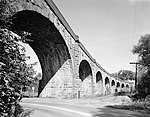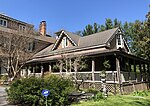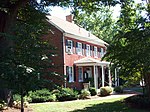Hockley Forge and Mill

The Hockley Forge and Mill are a collection of colonial-era industrial buildings along the Patapsco River near modern Elkridge, Maryland. Located at the river's head of navigation, the site is a flat section of land along the Patapsco River valley with steep embankments on either side. At its 19th-century peak, the site held more than 30 industrial buildings. Initially, the site was the Patapsco crossing of the "Old Indian Road" surveyed by Oliver Cromwell in 1734. In 1760, the forge site was surveyed by Edward Norwood; the forge itself was founded June 14 by Charles Carroll of Carrollton as the "Baltimore Company. Other partners included Charles Carroll of Duddington, Daniel and Walter Dulany, Charles Carroll (barrister) and Benjamin Tasker, Sr. who also operated two other forges. Operated by slaves, the forge produced goods to replace ones imported from England.When the old Baltimore forge burned down in April 1772, slaves were sent to work at the Hockley Forge.In 1781, the state of Maryland seized the company once owned in part by two Dulany cousins who were loyal to the British. Dan Dulany of Baltimore owned a remaining interest in the forge, and wrote the state to reimburse him for the loss in value due to losses sustained by loyalists in the colonial war. He cited that at the time, the forge property contained 100 acres and was operated by 98 slaves valued at 40 pounds each.Forge work depended on a declining supply of coal and wood which idled the plant in 1783. In 1794, Christopher Johnston purchased the property and sold the equipment from the slitting mill to George Elliott for his upstream mill in 1807. The property was auctioned on September 16, 1819, renovated by the Carroll and Oliver families and resold in 1822. A large distillery operation was put into operation by John McKim Jr. which ceased by 1833 when the Thomas Viaduct construction began. The mill continued in operation by George T Worthington until a fire in 1856. In 1868, a major flood damaged the four-story mill. The Levering family acquired the site and sold it in 1876 to the Viaduct Manufacturing Company. A street through the site is now named Levering Avenue. From 1906-1910, a 20-by-30-foot room was rented to Marion B. Davis, who manufactured brass screw threads and socket assemblies for automobiles delivered by horse and carriage. The Viaduct Company produced telegraph equipment onsite until it was abandoned in 1914. Since 1914, most of the remaining buildings have been demolished or destroyed by fire or flood.
Excerpt from the Wikipedia article Hockley Forge and Mill (License: CC BY-SA 3.0, Authors, Images).Hockley Forge and Mill
Darby Downs,
Geographical coordinates (GPS) Address Nearby Places Show on map
Geographical coordinates (GPS)
| Latitude | Longitude |
|---|---|
| N 39.2206 ° | E -76.7137 ° |
Address
Patapsco Valley State Park Deep Run Area
Darby Downs
21075
Maryland, United States
Open on Google Maps






